Cambodia
Lakhon Khol is being revived
Le Lakhon Kohl. an art form inscribed on UNESCO’s List of Intangible Cultural Heritage in Need of Urgent Safeguarding since November 28, 2018, is experiencing a revival after more than 14 years under the guidance of Marie-Claude and Hubert Macé from the NGO Good Fun. The masked theatrical performance, created in the 7th century in the village of Taskor, is slowly regaining its vibrancy. The couple now hopes that the troupe will be able to take their art beyond the village and, eventually, attract a tourist audience to monetize this activity. Taskor village is located 18 km from Phnom Penh, on the other side of the Mekong River, amidst the rural countryside. The contrast along the riverbanks is striking; by simply turning to the right, one can catch sight of the towering skyscrapers in the Koh Pich district, though the village remains surrounded by water, forests, and fields. Here stands the Wat Svay Andet Pagoda, literally meaning "floating mangoes," referring to the numerous fruit trees in the area that are affected by the rising waters during the monsoon season. The vast land dedicated to this religious temple also houses Taskor's kindergarten and school, along with a new building dedicated to the training and practice of Lakhon Khol.
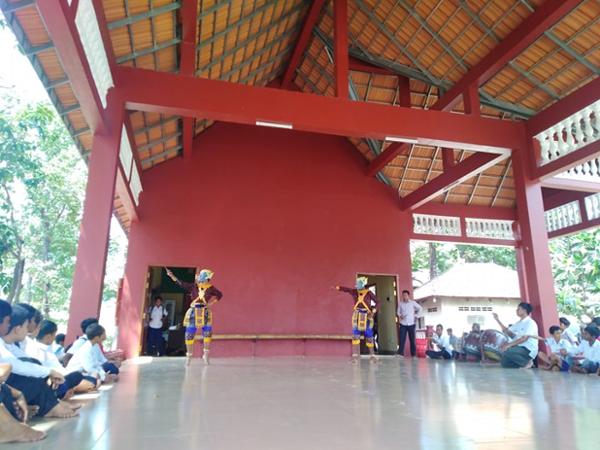
(Wat Svay Andet theater, in Taskor village. ©PierreMotin)
The renaissance
In the coolness of the Cambodian hinterland, this traditional Khmer theatrical art has existed for over 1,300 years. Theatre troupes have even multiplied throughout the country since its inception. However, this longevity has been marked by long periods of artistic void. The first of these occurred during what is known as Cambodia's "Dark Ages," immediately after the fall of the Empire (early 15th century) until the French Protectorate in 1863. The country was under pressure from the Siamese, who repeatedly attacked theatres hosting masked troupes. Lakhon Khol gradually lost momentum until the 20th century, when King Sisowath and later, in 1948, his grandson King Norodom Sihanouk, visited the birthplace of this traditional art in Taskor. However, the worst was yet to come for the Cambodian creative spirit as a whole. The Khmer Rouge, between 1975 and 1979, silenced all forms of art and culture that did not serve their propaganda. Survivors of Angkar, who later returned to Taskor, their native village, tried to revive Lakhon Khol. In 2005, Marie-Claude and Hubert Macé decided to create the Good Fun association to help the village rebuild. "I came here for the first time to administer malaria vaccinations to the local population," explains Marie-Claude. "We realized that the children were attending the village school but lacked the minimum necessary materials. So, we decided to provide them with the supplies and were immediately struck by Lakhon Khol, which was still being practiced in Taskor in a hall sponsored by UNESCO in the village. Today, the artists have a new building in the heart of the schoolyard, very close to the pagoda." Before the Khmer Rouge's arrival, eight masked theatre troupes performed in Cambodia; afterwards, only the troupe from Taskor, the birthplace of this art, remained.
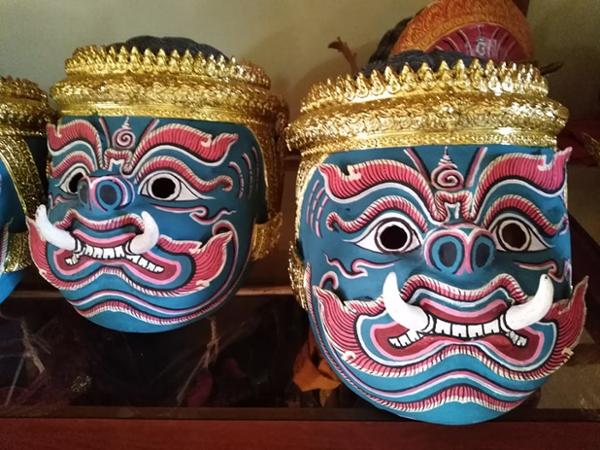
(Two masks of the giants from the Lakhon Khol performance ©PierreMotin)
UNESCO has indeed contributed to the revival of masked dances by also producing the instruments needed for the troupe's orchestra. With an annual budget of €130,000, the Good Fun association aims to continue providing financial support to this venue. "The artists make their own costumes. Today, we want to dedicate more money to providing them with better materials," admits Hubert, taking masks from the shelf. The theatre, covered by a roof but open on all sides, resembles a covered playground and includes the troupe director's office, which also serves as a changing room and storage for the costumes.
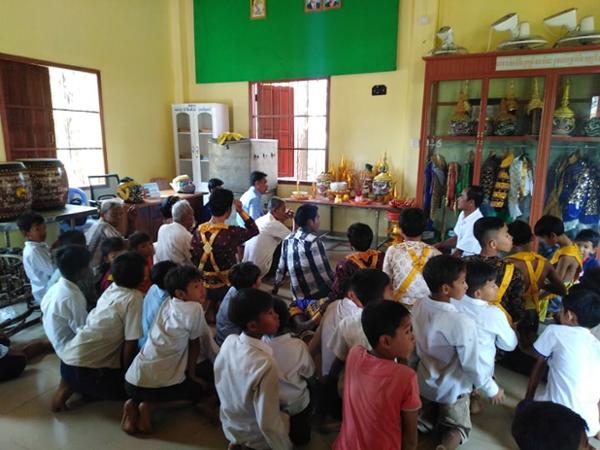
(The director’s office where the dancers change and where the costumes are stored. ©PierreMotin)
The monkeys' assault on the Giants
The art of Lakhon Khol masked theatre recounts many Khmer folk legends. The best-known is the Sanskrit epic *Ramakerti*, the Khmer version of the Ramayana, which tells the story of Rāma, one of the seven avatars of the Hindu god Vishnu. The performance, worked on by the Taskor troupe earlier this year, takes place in three stages. First, there is a prayer and offering session accompanied by traditional Khmer music performed by the troupe’s orchestra. Then the orchestra alone keeps the audience on edge until the masked and costumed dancers take the stage. In the legend, Prince Rāma is desperately in love with Sītā, one of Lakshmi's avatars, the goddess of fortune and Vishnu's consort. However, Sītā is suddenly kidnapped by the demon Rāvana and imprisoned in Lanka, a fortress city guarded by an army of giants. To rescue her, Rāma allies himself with the god Hanumān and his army of monkeys. A fierce battle then erupts at the gates of Lanka between the monkeys and the giants.
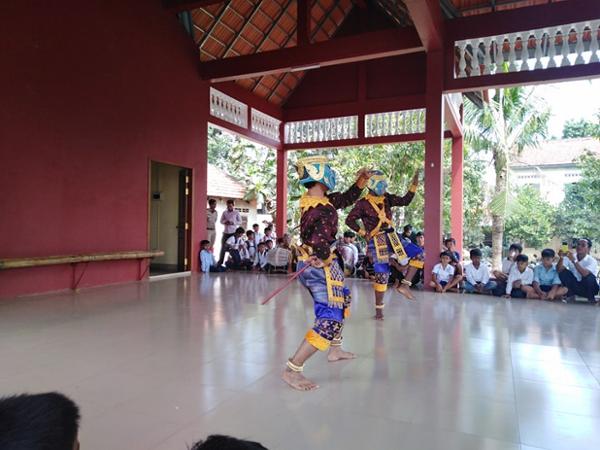
(The Giants open the ball…)
This story is told by the dancers of the troupe. The costumes and masks distinguish the monkeys from the giants. The former, smaller, expertly wield wooden daggers, while the latter, larger, proudly brandish majestic staffs. The Taskor troupe is exclusively male. Sītā is portrayed by a boy dressed as a female avatar for the occasion. At Wat Svay Andet, the roles are played by boys aged 9 to 15 from the neighboring school, while the musicians and dance teachers are adults from the village. Today, everyone gathers at 11 a.m. at the edge of the theatre to watch the performance.
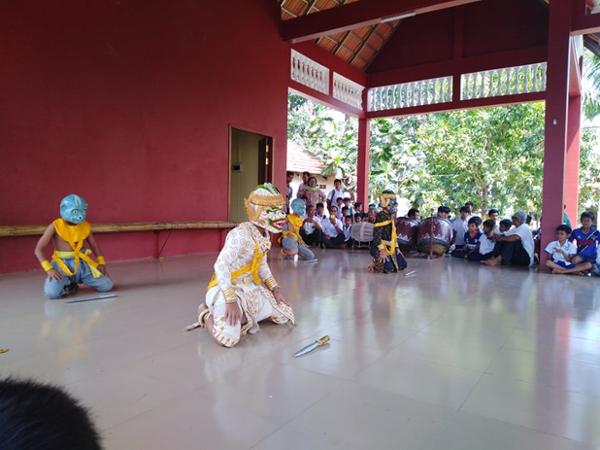
(… Quickly joined by the army of monkeys)
The school in the service of Art and Culture
About forty students are training inside the theatre before the performance. Phat, the teacher of the giant group, has around ten students aged 13 to 15. The monkey group is much larger, with about thirty children aged 9 to 10. This activity allows the young people of the village to clear their minds and practice a physically demanding dance. The movements must be repeated to perfection. "The movements of the back and head are essential," explains Marie-Claude. And to ensure that the girls are not left out, daily classical Khmer dance classes are also held in the educational space.
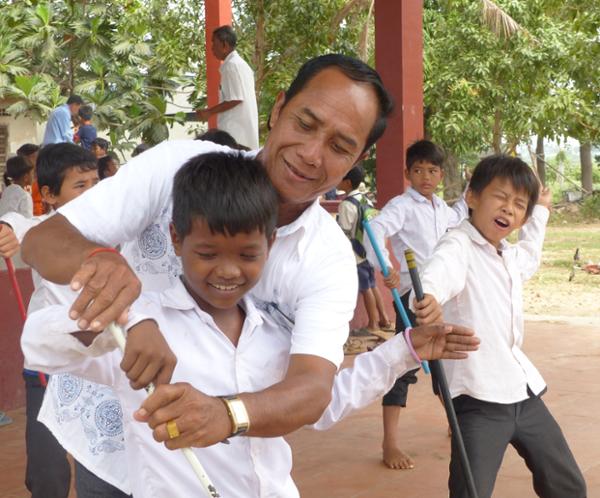
(Phat teaches the young dancers the art of the giants. ©MarionJoubert)
At Wat Svay Andet, school, art, and culture form a cohesive whole. Today, the overflowing motivation of everyone involved in this system allows the village to feel the positive energy of this ancestral culture, long forgotten. Marie-Claude and Hubert now hope that the village can profit from their sensational performances and monetize the experience. Exporting the performance could be an option, as could welcoming tourists. However, caution must be exercised regarding the dangers of such development, which could lead to the loss of this seemingly immortal soul, which, despite human catastrophes, has remained intact for thirteen centuries.
Thibault Bourru

